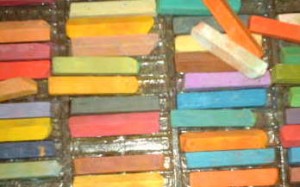In previous postings I spoke about my plein-air pastel painting experience. I thought it might be useful to pass on some basic knowledge on how to work with chalk pastels in and outside the studio environment.
 Pastels offer a quick and easy way to spread bright colors over large areas. Children (and adults) have varying responses to the chalky nature of these sticks of colour. For some they are much too messy and difficult to control, they smear, smudge and make dust that can spread across the table and over clothes. For others, blending and making new colours is attractive and fun. Each medium provides a set of varying characteristics. A person’s reaction is always telling in some way or other.
Pastels offer a quick and easy way to spread bright colors over large areas. Children (and adults) have varying responses to the chalky nature of these sticks of colour. For some they are much too messy and difficult to control, they smear, smudge and make dust that can spread across the table and over clothes. For others, blending and making new colours is attractive and fun. Each medium provides a set of varying characteristics. A person’s reaction is always telling in some way or other.
Applications: Pastels can be layered and rubbed into paper to create soft edges or bold patches of colour. They can be layered over an underpainting consisting of watercolour; mineral spirits or rubbing alcohol also can be used to dissolve pastel to create a permanent ‘stain’ on the paper. We do not use mineral spirits with children, watercolour is better suited and non-toxic.
Dust management: Working on an easel provides an incline to help the pastel dust fall off the paper. You can tape an L shape folded paper to the bottom to catch the dust that is then discarded in the garbage. Or use a tray for wallpaper on the ledge of your easel to catch the dust.
A spontaneous habit is to blow the dust off the page. DON’T! As you take a deep breath you are inhaling the pigment and clay dust. Instead you can tap the back of the paper over the garbage to get rid of the excess powder. Do this every so often to keep your colors clean. Children rarely work in so many layers or long enough for this type of consideration. But this is certainly not a fast rule. We usually do a final cleanup towards the end.
Another trick is to work on top of a piece of carpet. The carpet collects the dust to prevent it from being tracked through the room. The carpet is then vacuumed or shaken outside every so often. When doing plein-air work such considerations are unnecessary.
Cleaning. Pastel sticks get easily covered in dust from adjoining pastels or simply from manipulation. You can clean your sticks by wiping one by one, but you can also clean in batches, using a sieve filled with dry rice. Shake gently for a few minutes; the movement of the grains across the surface acts as a gentle abrasive, cleaning them back to their original colours. Discard rice and keep sieve for non-comestible uses only.
Keep wet-towelettes or a damp sponge close by to clean hands when working. Some wear gloves. I hate them. Some use a special cream to seal pores also useful with oil paints or sticks and acrylics.
Pastel papers: I spoke briefly about sanded paper here but there are other choices. What is essential is tooth, a rough enough surface that holds chalk. Sanded paper surfaces are ideal for this and come in different grades, just like sand paper for wood or metal sanding. The difference: it is archival meaning the acidity of the paper was neutralised to help it last (that is what is meant by archival). In art therapy we use a more readily available and more cost effective paper such as Canson which comes in different colors or simply regular drawing paper (with very little tooth results are what they are). See a list of pastel papers here.
Storage and transportation. There are differing views on using fixative in pastel painting. My recent teacher recommended not to use it. Fixative tends to darken colors and when not applied correctly leaves tiny stains. I know I ruined one. However some say differently. Read this article to find out. Keep in mind that fixatives will never make your pastel dustless. The chalky nature will always remain.
To store in process or finished artwork cover preferably in glassine paper or simple wax paper for kitchen use. Tape it to the back and fold over to cover entire surface. You want to protect the work from smudging from sideway movement.
To transport pastels and prevent breakage, storing in cornmeal or dry rice grains is recommended.
If you want to learn more on how to handle and work with pastels see this page. Some of the above recommendations come from Pastel Artists Canada.
Classé dans chalk, fixative, pastel, storage, technique, working with pastel.
Catégorisé dans Arts.
Publié le 04 sept 2009